Analyzing the Role of Nurses in Infection Control and Prevention
VerifiedAdded on 2023/06/11
|6
|1536
|343
Report
AI Summary
This report examines the significant role nurses play in infection control within healthcare settings, focusing on preventing hospital-acquired infections. It highlights key practices such as hand hygiene, sterilization, disinfection, and the use of protective equipment. The report also covers the importance of vaccination, isolation protocols, and continuous testing to manage and prevent the spread of infectious diseases. Furthermore, it emphasizes the necessity of training and education for both nurses and patients to maintain high standards of hygiene and sanitation, ultimately reducing the incidence of nosocomial infections. The paper concludes by underscoring the critical role of nurses in creating a safer healthcare environment through proactive infection control measures.
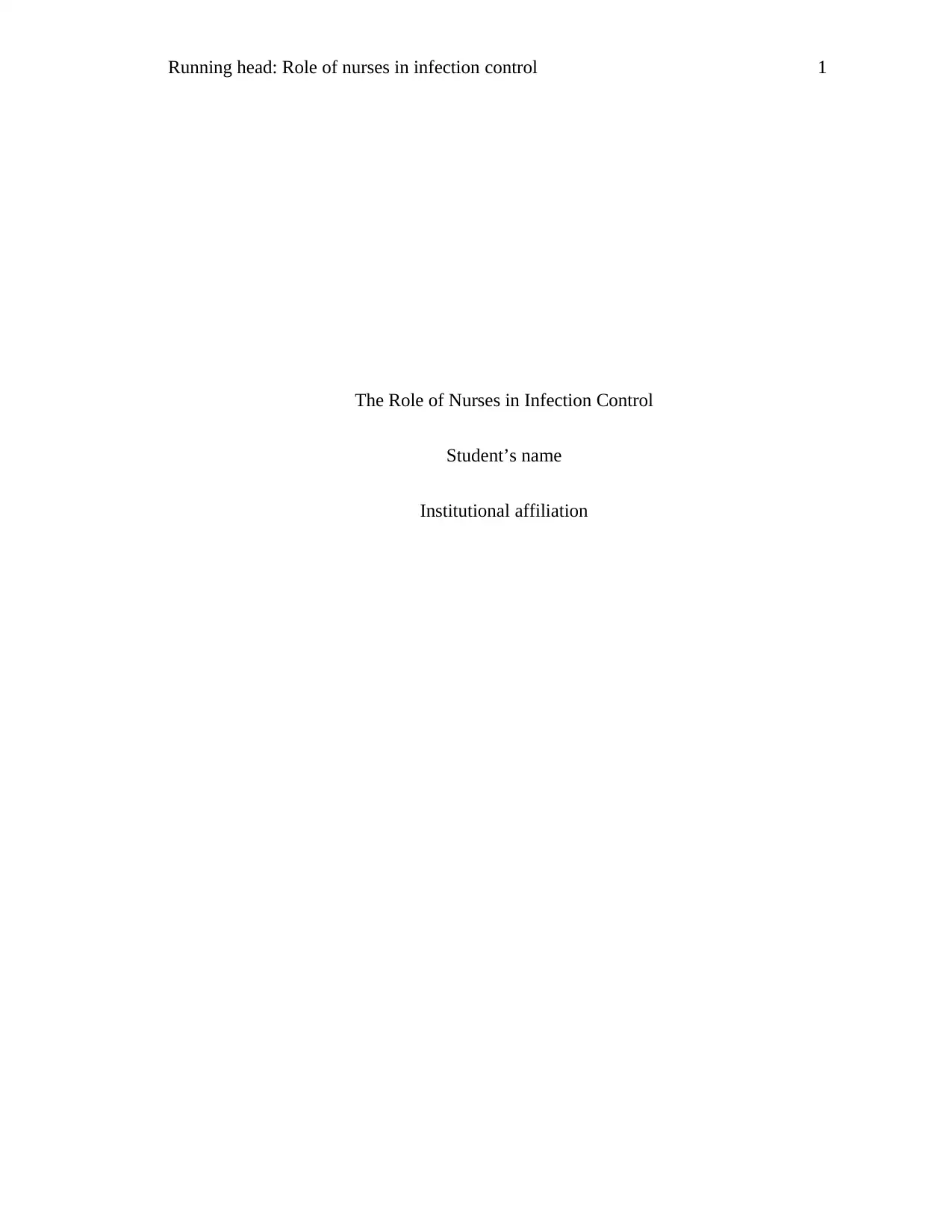
Running head: Role of nurses in infection control 1
The Role of Nurses in Infection Control
Student’s name
Institutional affiliation
The Role of Nurses in Infection Control
Student’s name
Institutional affiliation
Paraphrase This Document
Need a fresh take? Get an instant paraphrase of this document with our AI Paraphraser
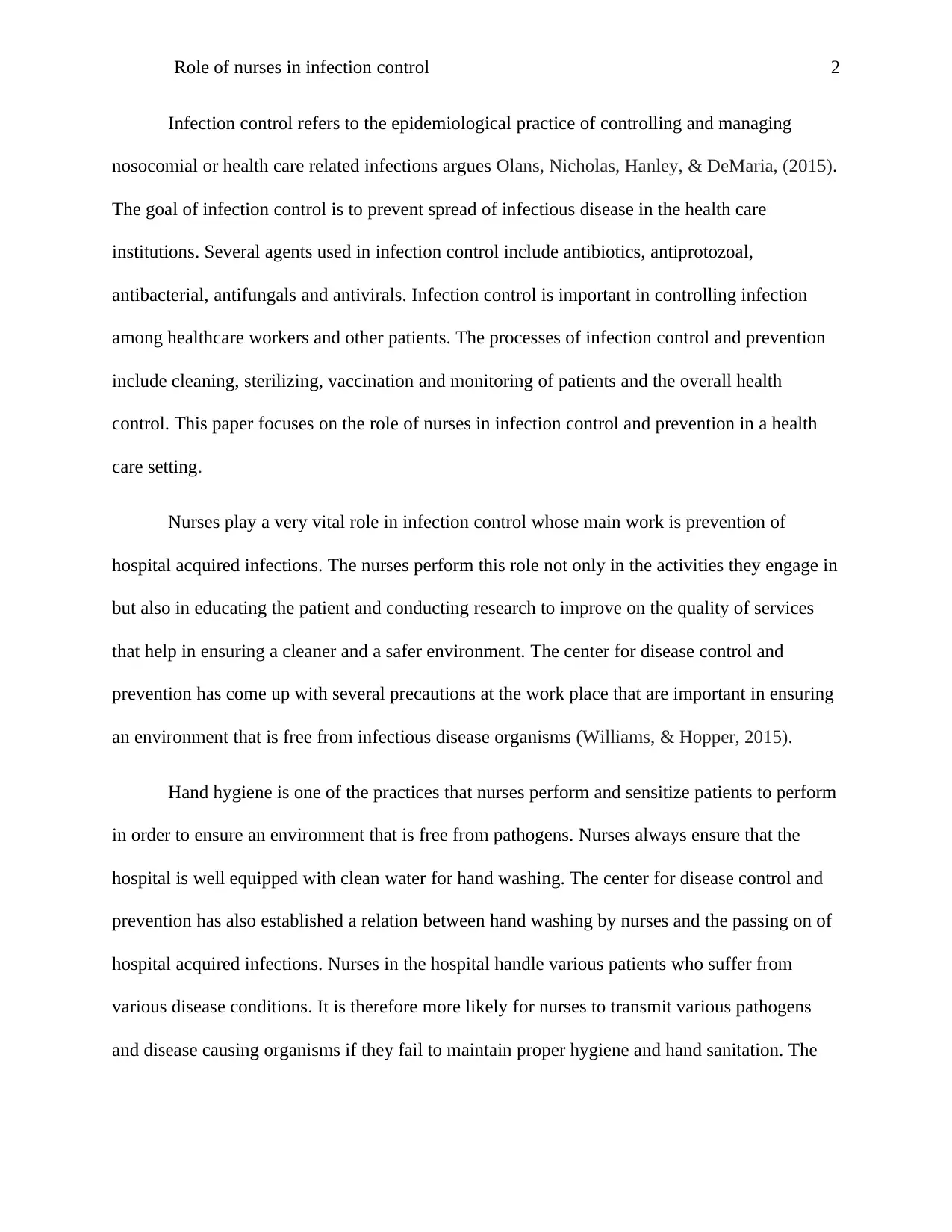
Role of nurses in infection control 2
Infection control refers to the epidemiological practice of controlling and managing
nosocomial or health care related infections argues Olans, Nicholas, Hanley, & DeMaria, (2015).
The goal of infection control is to prevent spread of infectious disease in the health care
institutions. Several agents used in infection control include antibiotics, antiprotozoal,
antibacterial, antifungals and antivirals. Infection control is important in controlling infection
among healthcare workers and other patients. The processes of infection control and prevention
include cleaning, sterilizing, vaccination and monitoring of patients and the overall health
control. This paper focuses on the role of nurses in infection control and prevention in a health
care setting.
Nurses play a very vital role in infection control whose main work is prevention of
hospital acquired infections. The nurses perform this role not only in the activities they engage in
but also in educating the patient and conducting research to improve on the quality of services
that help in ensuring a cleaner and a safer environment. The center for disease control and
prevention has come up with several precautions at the work place that are important in ensuring
an environment that is free from infectious disease organisms (Williams, & Hopper, 2015).
Hand hygiene is one of the practices that nurses perform and sensitize patients to perform
in order to ensure an environment that is free from pathogens. Nurses always ensure that the
hospital is well equipped with clean water for hand washing. The center for disease control and
prevention has also established a relation between hand washing by nurses and the passing on of
hospital acquired infections. Nurses in the hospital handle various patients who suffer from
various disease conditions. It is therefore more likely for nurses to transmit various pathogens
and disease causing organisms if they fail to maintain proper hygiene and hand sanitation. The
Infection control refers to the epidemiological practice of controlling and managing
nosocomial or health care related infections argues Olans, Nicholas, Hanley, & DeMaria, (2015).
The goal of infection control is to prevent spread of infectious disease in the health care
institutions. Several agents used in infection control include antibiotics, antiprotozoal,
antibacterial, antifungals and antivirals. Infection control is important in controlling infection
among healthcare workers and other patients. The processes of infection control and prevention
include cleaning, sterilizing, vaccination and monitoring of patients and the overall health
control. This paper focuses on the role of nurses in infection control and prevention in a health
care setting.
Nurses play a very vital role in infection control whose main work is prevention of
hospital acquired infections. The nurses perform this role not only in the activities they engage in
but also in educating the patient and conducting research to improve on the quality of services
that help in ensuring a cleaner and a safer environment. The center for disease control and
prevention has come up with several precautions at the work place that are important in ensuring
an environment that is free from infectious disease organisms (Williams, & Hopper, 2015).
Hand hygiene is one of the practices that nurses perform and sensitize patients to perform
in order to ensure an environment that is free from pathogens. Nurses always ensure that the
hospital is well equipped with clean water for hand washing. The center for disease control and
prevention has also established a relation between hand washing by nurses and the passing on of
hospital acquired infections. Nurses in the hospital handle various patients who suffer from
various disease conditions. It is therefore more likely for nurses to transmit various pathogens
and disease causing organisms if they fail to maintain proper hygiene and hand sanitation. The
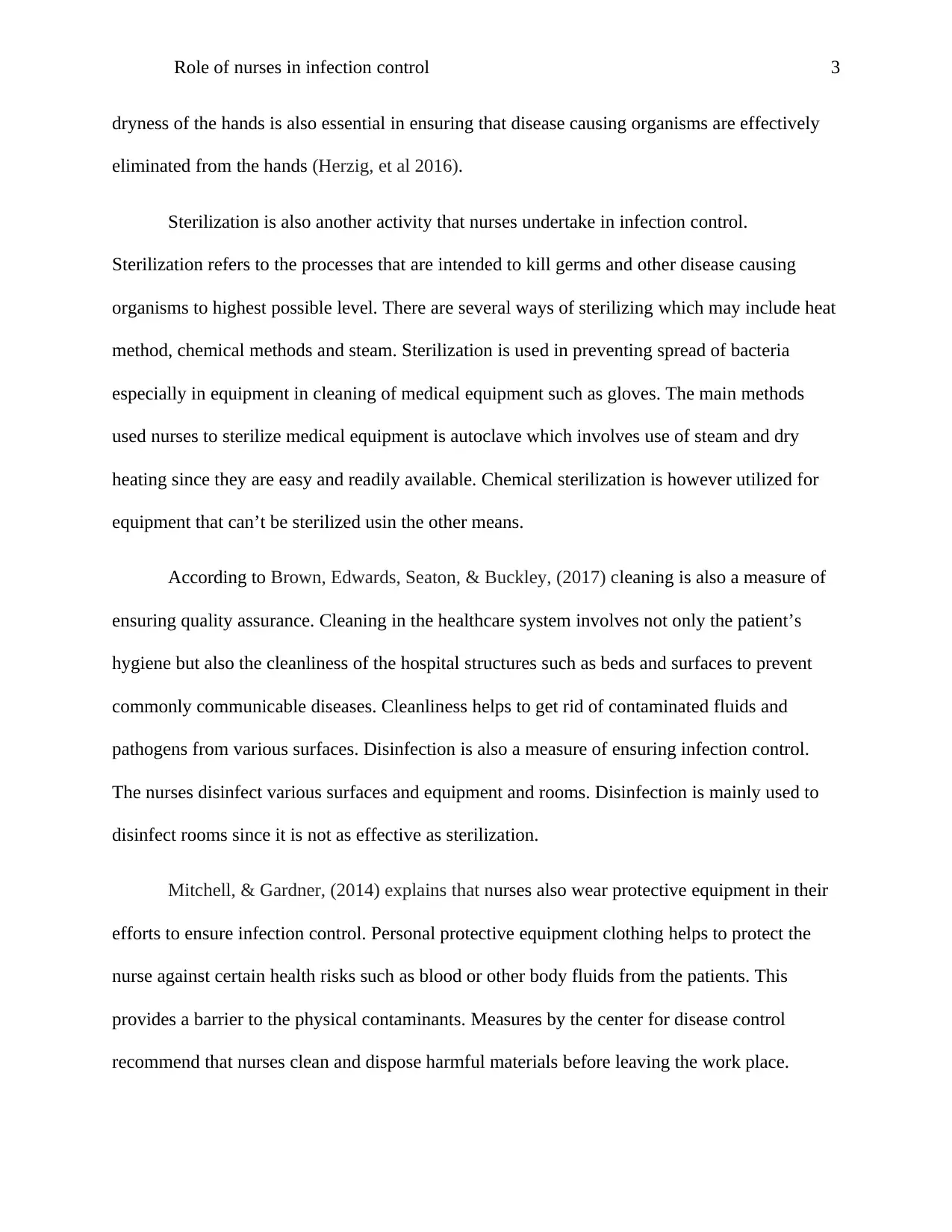
Role of nurses in infection control 3
dryness of the hands is also essential in ensuring that disease causing organisms are effectively
eliminated from the hands (Herzig, et al 2016).
Sterilization is also another activity that nurses undertake in infection control.
Sterilization refers to the processes that are intended to kill germs and other disease causing
organisms to highest possible level. There are several ways of sterilizing which may include heat
method, chemical methods and steam. Sterilization is used in preventing spread of bacteria
especially in equipment in cleaning of medical equipment such as gloves. The main methods
used nurses to sterilize medical equipment is autoclave which involves use of steam and dry
heating since they are easy and readily available. Chemical sterilization is however utilized for
equipment that can’t be sterilized usin the other means.
According to Brown, Edwards, Seaton, & Buckley, (2017) cleaning is also a measure of
ensuring quality assurance. Cleaning in the healthcare system involves not only the patient’s
hygiene but also the cleanliness of the hospital structures such as beds and surfaces to prevent
commonly communicable diseases. Cleanliness helps to get rid of contaminated fluids and
pathogens from various surfaces. Disinfection is also a measure of ensuring infection control.
The nurses disinfect various surfaces and equipment and rooms. Disinfection is mainly used to
disinfect rooms since it is not as effective as sterilization.
Mitchell, & Gardner, (2014) explains that nurses also wear protective equipment in their
efforts to ensure infection control. Personal protective equipment clothing helps to protect the
nurse against certain health risks such as blood or other body fluids from the patients. This
provides a barrier to the physical contaminants. Measures by the center for disease control
recommend that nurses clean and dispose harmful materials before leaving the work place.
dryness of the hands is also essential in ensuring that disease causing organisms are effectively
eliminated from the hands (Herzig, et al 2016).
Sterilization is also another activity that nurses undertake in infection control.
Sterilization refers to the processes that are intended to kill germs and other disease causing
organisms to highest possible level. There are several ways of sterilizing which may include heat
method, chemical methods and steam. Sterilization is used in preventing spread of bacteria
especially in equipment in cleaning of medical equipment such as gloves. The main methods
used nurses to sterilize medical equipment is autoclave which involves use of steam and dry
heating since they are easy and readily available. Chemical sterilization is however utilized for
equipment that can’t be sterilized usin the other means.
According to Brown, Edwards, Seaton, & Buckley, (2017) cleaning is also a measure of
ensuring quality assurance. Cleaning in the healthcare system involves not only the patient’s
hygiene but also the cleanliness of the hospital structures such as beds and surfaces to prevent
commonly communicable diseases. Cleanliness helps to get rid of contaminated fluids and
pathogens from various surfaces. Disinfection is also a measure of ensuring infection control.
The nurses disinfect various surfaces and equipment and rooms. Disinfection is mainly used to
disinfect rooms since it is not as effective as sterilization.
Mitchell, & Gardner, (2014) explains that nurses also wear protective equipment in their
efforts to ensure infection control. Personal protective equipment clothing helps to protect the
nurse against certain health risks such as blood or other body fluids from the patients. This
provides a barrier to the physical contaminants. Measures by the center for disease control
recommend that nurses clean and dispose harmful materials before leaving the work place.
⊘ This is a preview!⊘
Do you want full access?
Subscribe today to unlock all pages.

Trusted by 1+ million students worldwide
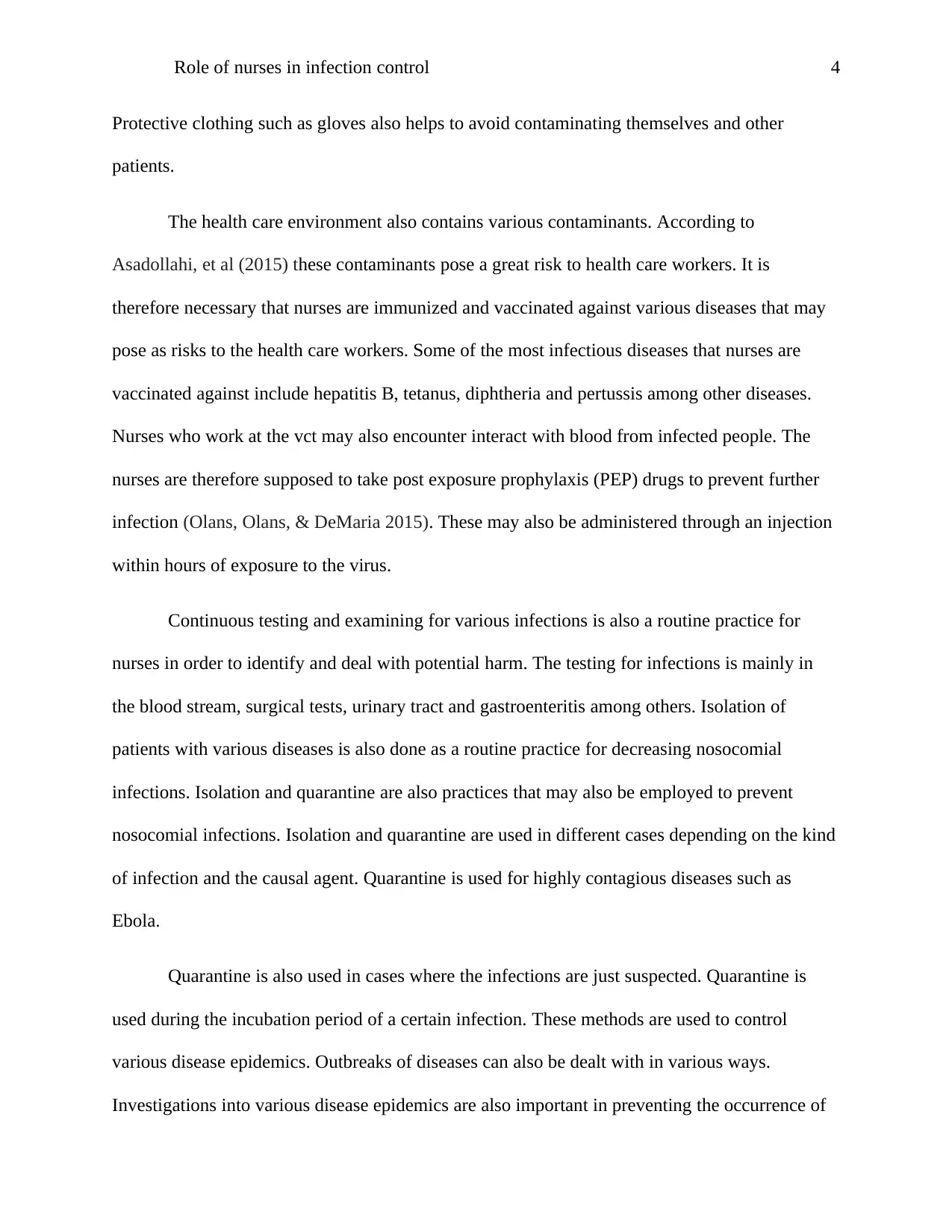
Role of nurses in infection control 4
Protective clothing such as gloves also helps to avoid contaminating themselves and other
patients.
The health care environment also contains various contaminants. According to
Asadollahi, et al (2015) these contaminants pose a great risk to health care workers. It is
therefore necessary that nurses are immunized and vaccinated against various diseases that may
pose as risks to the health care workers. Some of the most infectious diseases that nurses are
vaccinated against include hepatitis B, tetanus, diphtheria and pertussis among other diseases.
Nurses who work at the vct may also encounter interact with blood from infected people. The
nurses are therefore supposed to take post exposure prophylaxis (PEP) drugs to prevent further
infection (Olans, Olans, & DeMaria 2015). These may also be administered through an injection
within hours of exposure to the virus.
Continuous testing and examining for various infections is also a routine practice for
nurses in order to identify and deal with potential harm. The testing for infections is mainly in
the blood stream, surgical tests, urinary tract and gastroenteritis among others. Isolation of
patients with various diseases is also done as a routine practice for decreasing nosocomial
infections. Isolation and quarantine are also practices that may also be employed to prevent
nosocomial infections. Isolation and quarantine are used in different cases depending on the kind
of infection and the causal agent. Quarantine is used for highly contagious diseases such as
Ebola.
Quarantine is also used in cases where the infections are just suspected. Quarantine is
used during the incubation period of a certain infection. These methods are used to control
various disease epidemics. Outbreaks of diseases can also be dealt with in various ways.
Investigations into various disease epidemics are also important in preventing the occurrence of
Protective clothing such as gloves also helps to avoid contaminating themselves and other
patients.
The health care environment also contains various contaminants. According to
Asadollahi, et al (2015) these contaminants pose a great risk to health care workers. It is
therefore necessary that nurses are immunized and vaccinated against various diseases that may
pose as risks to the health care workers. Some of the most infectious diseases that nurses are
vaccinated against include hepatitis B, tetanus, diphtheria and pertussis among other diseases.
Nurses who work at the vct may also encounter interact with blood from infected people. The
nurses are therefore supposed to take post exposure prophylaxis (PEP) drugs to prevent further
infection (Olans, Olans, & DeMaria 2015). These may also be administered through an injection
within hours of exposure to the virus.
Continuous testing and examining for various infections is also a routine practice for
nurses in order to identify and deal with potential harm. The testing for infections is mainly in
the blood stream, surgical tests, urinary tract and gastroenteritis among others. Isolation of
patients with various diseases is also done as a routine practice for decreasing nosocomial
infections. Isolation and quarantine are also practices that may also be employed to prevent
nosocomial infections. Isolation and quarantine are used in different cases depending on the kind
of infection and the causal agent. Quarantine is used for highly contagious diseases such as
Ebola.
Quarantine is also used in cases where the infections are just suspected. Quarantine is
used during the incubation period of a certain infection. These methods are used to control
various disease epidemics. Outbreaks of diseases can also be dealt with in various ways.
Investigations into various disease epidemics are also important in preventing the occurrence of
Paraphrase This Document
Need a fresh take? Get an instant paraphrase of this document with our AI Paraphraser
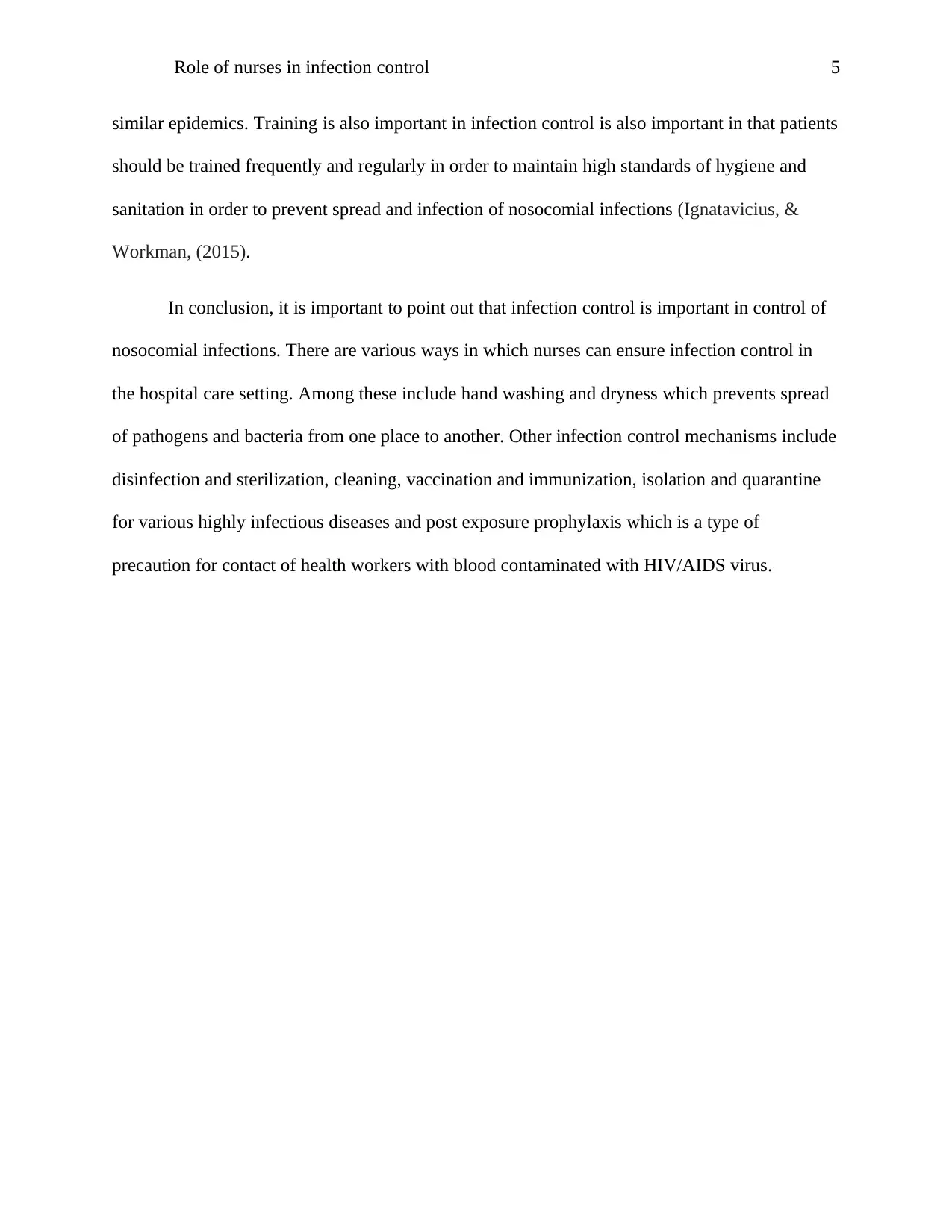
Role of nurses in infection control 5
similar epidemics. Training is also important in infection control is also important in that patients
should be trained frequently and regularly in order to maintain high standards of hygiene and
sanitation in order to prevent spread and infection of nosocomial infections (Ignatavicius, &
Workman, (2015).
In conclusion, it is important to point out that infection control is important in control of
nosocomial infections. There are various ways in which nurses can ensure infection control in
the hospital care setting. Among these include hand washing and dryness which prevents spread
of pathogens and bacteria from one place to another. Other infection control mechanisms include
disinfection and sterilization, cleaning, vaccination and immunization, isolation and quarantine
for various highly infectious diseases and post exposure prophylaxis which is a type of
precaution for contact of health workers with blood contaminated with HIV/AIDS virus.
similar epidemics. Training is also important in infection control is also important in that patients
should be trained frequently and regularly in order to maintain high standards of hygiene and
sanitation in order to prevent spread and infection of nosocomial infections (Ignatavicius, &
Workman, (2015).
In conclusion, it is important to point out that infection control is important in control of
nosocomial infections. There are various ways in which nurses can ensure infection control in
the hospital care setting. Among these include hand washing and dryness which prevents spread
of pathogens and bacteria from one place to another. Other infection control mechanisms include
disinfection and sterilization, cleaning, vaccination and immunization, isolation and quarantine
for various highly infectious diseases and post exposure prophylaxis which is a type of
precaution for contact of health workers with blood contaminated with HIV/AIDS virus.
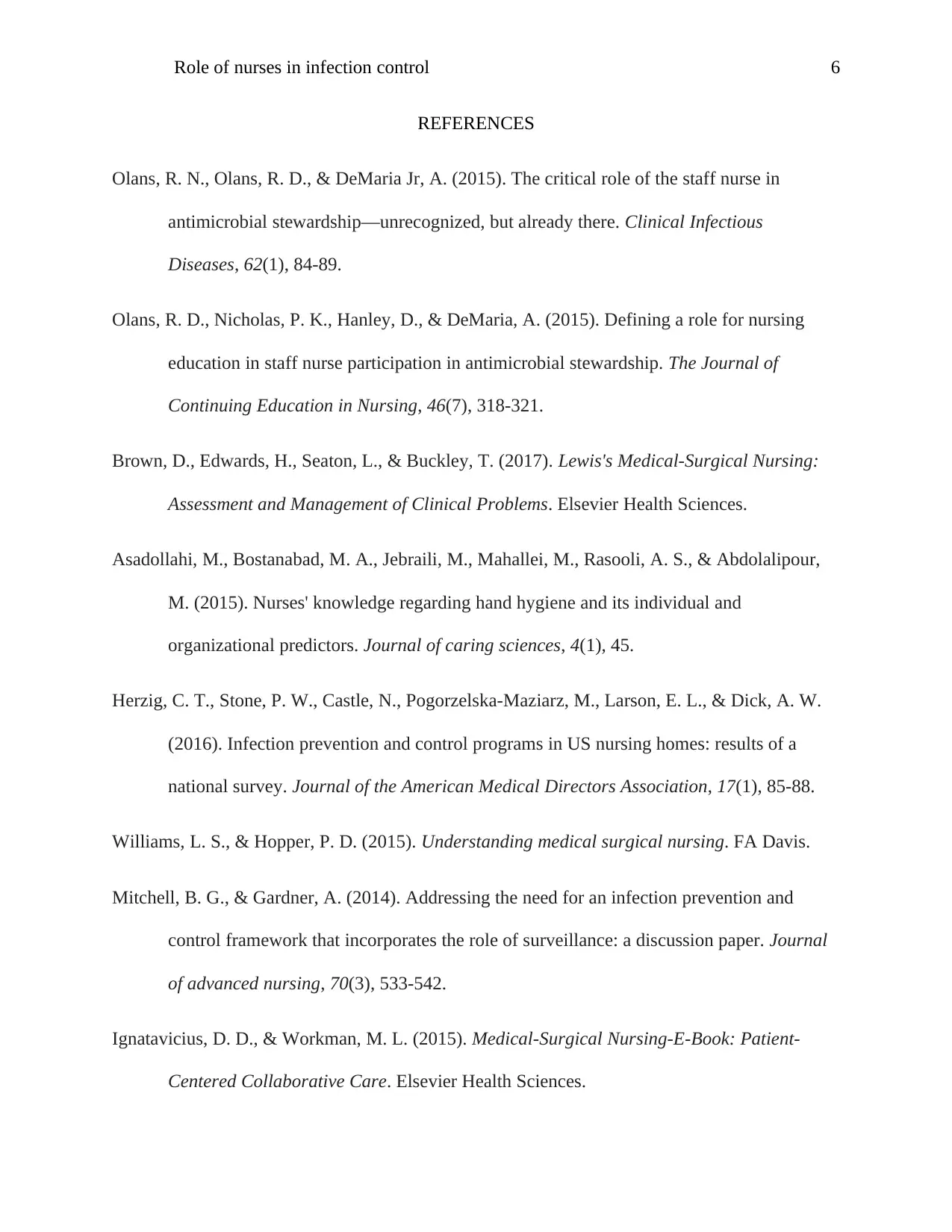
Role of nurses in infection control 6
REFERENCES
Olans, R. N., Olans, R. D., & DeMaria Jr, A. (2015). The critical role of the staff nurse in
antimicrobial stewardship—unrecognized, but already there. Clinical Infectious
Diseases, 62(1), 84-89.
Olans, R. D., Nicholas, P. K., Hanley, D., & DeMaria, A. (2015). Defining a role for nursing
education in staff nurse participation in antimicrobial stewardship. The Journal of
Continuing Education in Nursing, 46(7), 318-321.
Brown, D., Edwards, H., Seaton, L., & Buckley, T. (2017). Lewis's Medical-Surgical Nursing:
Assessment and Management of Clinical Problems. Elsevier Health Sciences.
Asadollahi, M., Bostanabad, M. A., Jebraili, M., Mahallei, M., Rasooli, A. S., & Abdolalipour,
M. (2015). Nurses' knowledge regarding hand hygiene and its individual and
organizational predictors. Journal of caring sciences, 4(1), 45.
Herzig, C. T., Stone, P. W., Castle, N., Pogorzelska-Maziarz, M., Larson, E. L., & Dick, A. W.
(2016). Infection prevention and control programs in US nursing homes: results of a
national survey. Journal of the American Medical Directors Association, 17(1), 85-88.
Williams, L. S., & Hopper, P. D. (2015). Understanding medical surgical nursing. FA Davis.
Mitchell, B. G., & Gardner, A. (2014). Addressing the need for an infection prevention and
control framework that incorporates the role of surveillance: a discussion paper. Journal
of advanced nursing, 70(3), 533-542.
Ignatavicius, D. D., & Workman, M. L. (2015). Medical-Surgical Nursing-E-Book: Patient-
Centered Collaborative Care. Elsevier Health Sciences.
REFERENCES
Olans, R. N., Olans, R. D., & DeMaria Jr, A. (2015). The critical role of the staff nurse in
antimicrobial stewardship—unrecognized, but already there. Clinical Infectious
Diseases, 62(1), 84-89.
Olans, R. D., Nicholas, P. K., Hanley, D., & DeMaria, A. (2015). Defining a role for nursing
education in staff nurse participation in antimicrobial stewardship. The Journal of
Continuing Education in Nursing, 46(7), 318-321.
Brown, D., Edwards, H., Seaton, L., & Buckley, T. (2017). Lewis's Medical-Surgical Nursing:
Assessment and Management of Clinical Problems. Elsevier Health Sciences.
Asadollahi, M., Bostanabad, M. A., Jebraili, M., Mahallei, M., Rasooli, A. S., & Abdolalipour,
M. (2015). Nurses' knowledge regarding hand hygiene and its individual and
organizational predictors. Journal of caring sciences, 4(1), 45.
Herzig, C. T., Stone, P. W., Castle, N., Pogorzelska-Maziarz, M., Larson, E. L., & Dick, A. W.
(2016). Infection prevention and control programs in US nursing homes: results of a
national survey. Journal of the American Medical Directors Association, 17(1), 85-88.
Williams, L. S., & Hopper, P. D. (2015). Understanding medical surgical nursing. FA Davis.
Mitchell, B. G., & Gardner, A. (2014). Addressing the need for an infection prevention and
control framework that incorporates the role of surveillance: a discussion paper. Journal
of advanced nursing, 70(3), 533-542.
Ignatavicius, D. D., & Workman, M. L. (2015). Medical-Surgical Nursing-E-Book: Patient-
Centered Collaborative Care. Elsevier Health Sciences.
⊘ This is a preview!⊘
Do you want full access?
Subscribe today to unlock all pages.

Trusted by 1+ million students worldwide
1 out of 6
Related Documents
Your All-in-One AI-Powered Toolkit for Academic Success.
+13062052269
info@desklib.com
Available 24*7 on WhatsApp / Email
![[object Object]](/_next/static/media/star-bottom.7253800d.svg)
Unlock your academic potential
Copyright © 2020–2025 A2Z Services. All Rights Reserved. Developed and managed by ZUCOL.





